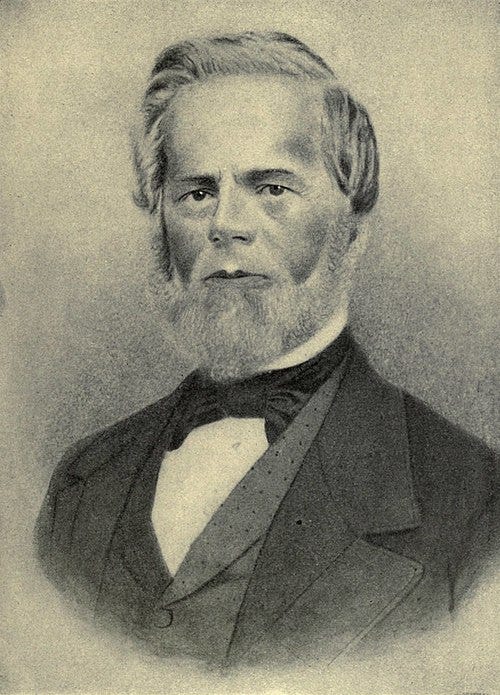The Incredible Story of Phineas Parkhurst Quimby: The Power of the Mind-Body Connection Before Our Time
A humble man from Maine revealed the science of Epigenetics over 100 years ago
Image credit unknown; courtesy of George A. Quimby
What if the secret to healing wasn’t hidden in a pill, a procedure, or a doctor’s hands, but in your own mind? Long before modern science began to prove the link between thought and biology, a self-taught healer from Maine was demonstrating that belief itself could be a form of medicine.
Let’s go back in history. Long before epigenetics became a field of science, and a century before Dr. Bruce H Lipton’s The Biology of Belief: Unleashing The Power Of Consciousness, Matter And Miracles linked thought to cellular behavior, a self-taught healer from Maine was proving it through experience.
His name was Phineas Parkhurst Quimby, and his discoveries in the mid-1800s revealed something modern science is still catching up to: the mind shapes the body. Quimby wasn’t a doctor. He was a clockmaker and inventor whose true passion became understanding human suffering and finding ways to heal.
Medical practices of the past, oh my
In an era when medicine relied on leeches, bleeding, and toxic tonics, he noticed that people’s beliefs about their illness often determined their recovery. When a patient believed they were dying, they usually did. But when that belief shifted, healing followed.
He concluded that disease begins not in the body, but in the mind. “If a person believes he has a disease,” he wrote, “he has it; and the cause is in his belief.”
That simple statement anticipated what neuroscience and quantum biology later confirmed: our perceptions have a profound influence on our biology. Decades later, Bruce Lipton’s work demonstrated that thoughts and emotions send chemical messages that activate or deactivate genes, literally altering our physiology.
You don’t have to be religious to believe any of this
Quimby intuited the same truth without a lab, a microscope, or a PhD. He called his method the “Science of Christ,” meaning the divine wisdom within each of us that restores harmony when we align with truth. His teachings went on to inspire a generation of spiritual pioneers, including Mary Baker Eddy, the founder of Christian Science, who was once his patient and student.
He also influenced Warren Felt Evans, a Swedenborgian minister, who adapted his ideas into early New Thought philosophy, and his influence spread to leaders like Emma Curtis Hopkins, also known as “the teacher of teachers.” Hopkins trained many of the later New Thought teachers. For example, she mentored Charles and Myrtle Fillmore, the founders of Unity Church; Ernest Holmes, author of The Science of Mind; and other central figures behind New Thought.
Quimby attracted intelligent, influential people because he demonstrated, through simple language and direct experience, that the mind could heal the body and that disease often originated from a false belief.
Dogmatic thinking has a bite
Being too dogmatic can be hazardous to one’s health. But imagine what life was like in the 1800s in an era dominated by rigid medical practices and dogmatic religion.
Quimby’s vision offered hope: that healing and transformation were available to ordinary people through inner alignment with truth and the power of belief.
Quimby would sit with patients, listen deeply, and help them identify the false ideas, fear, guilt, or despair that had taken root in their minds. The body began to heal when a patient overrode prior beliefs; the power of the subconscious mind is real.
Quimby’s legacy influenced a wave of thinkers, including one of my heroes, Ralph Waldo Emerson, Joseph Murphy, the author of one of my favorite books, The Power of the Subconscious Mind, which I recently reread.
All of these people carried forward the same core principle: change your thinking, and you change your life. It all begins with an open mind, a willing heart, and a genuine desire to believe.
My experience, faith converges with science
Fast forward to today, and I can personally attest to the truth Quimby intuited. What’s more, in my early 40s, when suffering from a debilitating back pain, I had surgery that led to recurring issues. I needed a walker to get around, and I knew a pain I wouldn’t wish on my worst enemies.
However, by studying and practicing the work of John E. Sarno, M.D. Specifically, I experienced direct and profound healing from back pain through the books Healing Back Pain: The Mind-Body Connection and The Divided Mind: The Epidemic of Mind-Body Disorders.
Today, I practice this wisdom every day, and it’s how I remain lean, fit, and pain-free, with less than a year to go before I’m eligible for Medicare.
Common sense shouldn’t be rare, but it is
Sarno’s and Lipton’s research made complete sense to me. What they wrote made a profound difference. Modern-day doctors and scientists reinforced what Quimby's insights over a century earlier revealed: how unconscious emotions manifest in the body as pain.
It’s all about how awareness, faith, and alignment with truth can restore health. My own recovery stands as living proof of the same mind-body connection Quimby pioneered. All I needed to do was shift my thinking.
Millions beyond my story have experienced the same truth: healing begins when our beliefs change. Those unwilling to look within, clinging to doubt or bias, will carry their pain like a badge of honor and never understand why they fail to recover.
The humble man from Maine practiced the biology of belief long before science gave it a name. Quimby recognized every human being as a self-healing system guided by divine intelligence. Today, modern research confirms what he proved in practice: when we shift our consciousness, our biology follows, and true healing begins.
I’m an author and strategic coach. Join me for live, weekly Zoom calls and discover the power of the Clarity S.H.I.F.T. Method® for improving your business, career, and life at www.CliffordJones.com.



